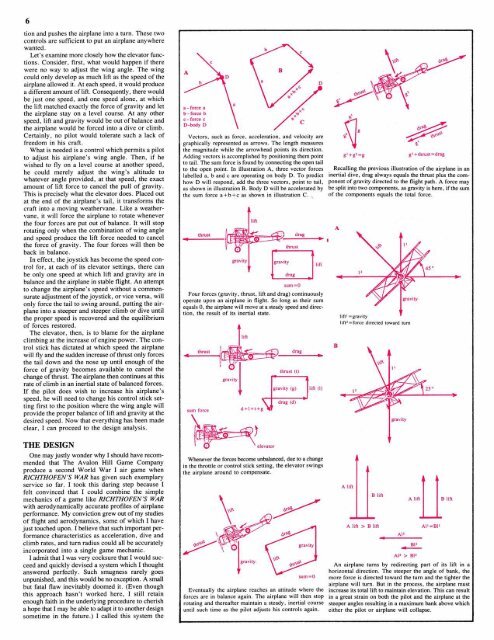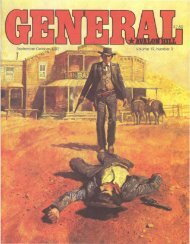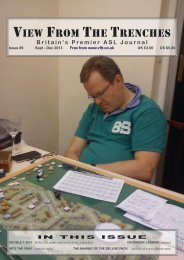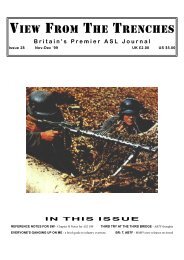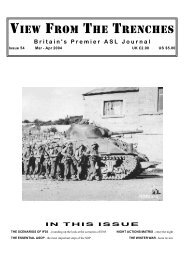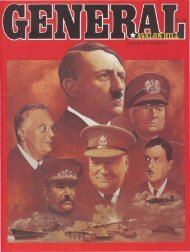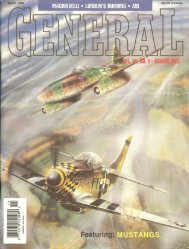18.64MB - View From The Trenches
18.64MB - View From The Trenches
18.64MB - View From The Trenches
- TAGS
- trenches
- www.vftt.co.uk
Create successful ePaper yourself
Turn your PDF publications into a flip-book with our unique Google optimized e-Paper software.
6<br />
tion and pushes the airplane into a turn. <strong>The</strong>se two<br />
controls are sufficient to put an airplane anywhere<br />
wanted.<br />
Let's examine more closely how the elevator func-<br />
tions. Consider, first, what would happen if there<br />
were no way to adjust the wing angle. <strong>The</strong> wing<br />
could only develop as much lift as the speed of the<br />
airplane allowed it. At each speed, it would produce<br />
a different amount of lift. Consequently, there would<br />
be just one speed, and one speed alone, at which<br />
the lift matched exactly the force of gravity and let<br />
the airplane stay on a level course. At any other<br />
speed, lift and gravity would be out of balance and<br />
the airplane would be forced into a dive or climb.<br />
Certainly, no pilot would tolerate such a lack of<br />
freedom in his craft.<br />
What is needed is a control which permits a pilot<br />
to adjust his airplane's wing angle. <strong>The</strong>n, if he<br />
wished to fly on a level course at another speed,<br />
he could merely adjust the wing's altitude to<br />
whatever angle provided, at that speed, the exact<br />
amount of lift force to cancel the pull of gravity.<br />
This is precisely what the elevator does. Placed out<br />
at the end of the airplane's tail, it transforms the<br />
craft into a moving weathervane. Like a weather-<br />
vane, it will force the airplane to rotate whenever<br />
the four forces are put out of balance. It will stop<br />
rotatlng only when the combination of wing angle<br />
and speed produce the lift force needed to cancel<br />
the force of gravity. <strong>The</strong> four forces will then be<br />
back in balance.<br />
In effect, the joystick has become the speed con-<br />
trol for, at each of its elevator settings, there can<br />
be only one speed at which lift and gravity are in<br />
balance and the airplane in stable flight. An attempt<br />
to change the airplane's speed without a commen-<br />
surate adjustment of the joystick, or vice versa, will<br />
only force the tail to swing around, putting the air-<br />
plane into a steeper and steeper climb or dive until<br />
the proper speed is recovered and the equilibrium<br />
of forces restored.<br />
<strong>The</strong> elevator, then, is to blame for the airplane<br />
climbing at the increase of engine power. <strong>The</strong> con-<br />
trol stick has dictated at which speed the airplane<br />
will fly and the sudden increase of thrust only forces<br />
the tail down and the nose up until enough of the<br />
force of gravity becomes available to cancel the<br />
change of thrust. <strong>The</strong> airplane then continues at this<br />
rate of climb in an inertial state of balanced forces.<br />
If the pilot does wish to increase his airplane's<br />
speed, he will need to change his control stick set-<br />
ting first to the position where the wing angle will<br />
provide the proper balance of lift and gravity at the<br />
desired speed. Now that everything has been made<br />
clear, I can proceed to the design analysis.<br />
THE DESIGN<br />
One may justly wonder why I should have recom-<br />
mended that <strong>The</strong> Avalon Hill Game Company<br />
produce a second World War I air game when<br />
RICHTHOFEN'S WAR has given such exemplary<br />
service so far. I took this daring step because I<br />
felt convinced that I could combine the simple<br />
mechanics of a game like RICHTHOFEN'S WAR<br />
with aerodynamically accurate profiles of airplane<br />
performance. My conviction grew out of my studies<br />
of flight and aerodynamics, some of which I have<br />
just touched upon. I believe that such important per-<br />
formance characteristics as acceleration, dive and<br />
climb rates, and turn radius could all be accurately<br />
incorporated into a single game mechanic.<br />
I admit that I was very cocksure that I would suc-<br />
ceed and quickly devised a system which I thought<br />
answered perfectly. Such smugness rarely goes<br />
unpunished, and this would be no exception. A small<br />
but fatal flaw inevitably doomed it. (Even though<br />
this approach hasn't worked here, I still retain<br />
enough faith in the underlying procedure to cherish<br />
a hope that I may be able to adapt it to another design<br />
sometime in the future.) I called this system the<br />
a - force a<br />
b - force b<br />
c - force c<br />
D-body D<br />
9<br />
Vectors, such as force, acceleration, and velocity are<br />
graphically represented as arrows. <strong>The</strong> length measures<br />
the magnitude while the arrowhead points its direction.<br />
Adding vectors is accomplished by positioning them point g'+g2=g g' +thrust =drag<br />
to tail. <strong>The</strong> sum force is found by connecting the open tail<br />
to the open point. In illustration A, three vector forces Recalling the previous illustration of the airplane in an<br />
labelled a, b and c are operating on body D. To predict inertial dive, drag always equals the thrust plus the com-<br />
how D will respond, add the three vectors, point to tail, ponent of gravity directed to the flight path. A force may<br />
as shown in illustration B. Body D will be accelerated by be split into two components, as gravity is here, if the sum<br />
the sum force a+b+c as shown in illustration C. . of the components equals the total force.<br />
thrust<br />
7 I<br />
sum=0<br />
Four forces (gravity, thrust, lift and drag) continuously<br />
operate upon an airplane in flight. So long as their sum<br />
equals 0, the airplane will move at a steady speed and direc-<br />
tion, the result of its inertial state.<br />
sum force<br />
thrust (t)<br />
Whenever the forces become unbalanced, due to a change<br />
in the throttle or control stick setting, the elevator swings<br />
the airplane around to compensate.<br />
B<br />
Ilft2=force d~rected toward turn<br />
AIiftllBlm f t l<br />
A lift s B lift AI'=BI1<br />
A12<br />
7<br />
BIZ<br />
Al' > B12<br />
An airplane turns by redirecting part of its lift in a<br />
horizontal direction. <strong>The</strong> steeper the angle of bank, the<br />
SUm=O more force is directed toward the turn and the tighter the<br />
airplane will turn. But in the process, the airplane must<br />
Eventually the airplane reaches an attitude where the increase its total lift to maintain elevation. This can result<br />
forces are in balance again. <strong>The</strong> airplane will then stop in a great strain on both the pilot and the airplane at the<br />
rotating and thereafter maintain a steady, inertial course steeper angles resulting in a maximum bank above which<br />
until such time as the pilot adjusts his controls again. either the pilot or airplane will collapse.


